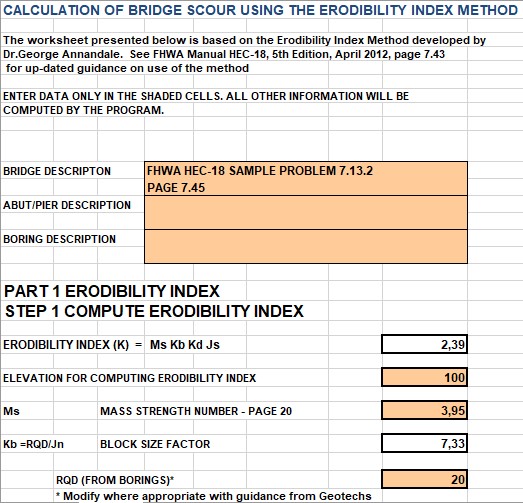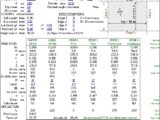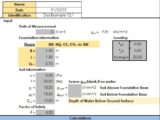
Calculation Of Bridge Scour Using The Erodibility Index Method Spreadsheet
22 January 2022Table of Contents
Calculation Of Bridge Scour Using The Erodibility Index Method Spreadsheet
What Is Bridge Scour?
Bridge scour occurs when fast-moving water erodes the soil, sand, or rock surrounding a bridge’s abutments and piers. This erosion creates a void that can compromise the bridge’s structural integrity over time. Scour is most commonly caused by floods, storms, and other high-flow water events that increase the velocity and turbulence of water streams.
Types of bridge scour include:
- Local Scour: Erosion that happens around individual bridge piers or abutments due to increased turbulence.
- General Scour: Erosion that occurs across the entire riverbed over time, unrelated to the presence of the bridge.
- Contraction Scour: Erosion caused when water flow is constricted due to a narrowed channel, increasing velocity and force.
Understanding these types is essential for identifying vulnerabilities and implementing appropriate countermeasures.
Why Is Bridge Scour a Serious Concern?
The consequences of bridge scour can be devastating. From a safety perspective, bridges weakened by scour may collapse without warning, leading to potential loss of life and severe economic repercussions. According to the Federal Highway Administration (FHWA), more than 60% of bridge failures in the United States are linked to scour-related issues.
Beyond the immediate danger, bridge failures disrupt transportation networks, impact emergency response times, and strain local economies. With climate change increasing the frequency of extreme weather events, the risk posed by bridge scour is expected to grow in the coming years.
Identifying Bridge Scour Risks
Early detection of bridge scour is critical for preventing catastrophic failures. Engineers rely on a combination of methods to assess and monitor scour risk, including:
- Visual Inspections: Regular on-site evaluations to identify signs of erosion and structural distress.
- Hydraulic Modeling: Simulations that predict how water flow interacts with the bridge structure.
- Scour Sensors: Advanced sensors that measure real-time changes in sediment levels around bridge foundations.
- Diver Surveys: Underwater inspections by professional divers to assess the extent of scour damage.
Mitigating Bridge Scour: Effective Solutions
Preventing bridge scour involves a mix of engineering solutions and proactive monitoring. Key strategies include:
- Riprap Placement: Adding large rocks or concrete blocks around bridge piers to stabilize the surrounding soil and reduce erosion.
- Scour-Resistant Materials: Using durable materials for bridge foundations to withstand the impact of high-velocity water flows.
- Scour Countermeasures: Installing flow-deflecting devices like collars or fins to redirect water currents away from vulnerable areas.
- Bridge Design Improvements: Elevating bridge foundations or redesigning them to minimize exposure to erosive forces.
The Role of Technology in Bridge Scour Prevention
Modern technology has revolutionized how engineers address scour-related challenges. Tools like LiDAR, drones, and real-time monitoring systems allow for accurate data collection and early identification of risks. Machine learning algorithms are also being applied to predict scour events and optimize maintenance schedules, ensuring bridges remain safe and operational.
Conclusion
Bridge scour may be an invisible threat, but its impacts are anything but negligible. By understanding the causes, consequences, and mitigation strategies, engineers and policymakers can work together to safeguard critical infrastructure and protect public safety.
As climate change continues to reshape our natural environment, addressing bridge scour must remain a top priority in infrastructure management. Investing in innovative technologies and resilient designs will not only extend the lifespan of our bridges but also help us navigate the challenges of an unpredictable future.


